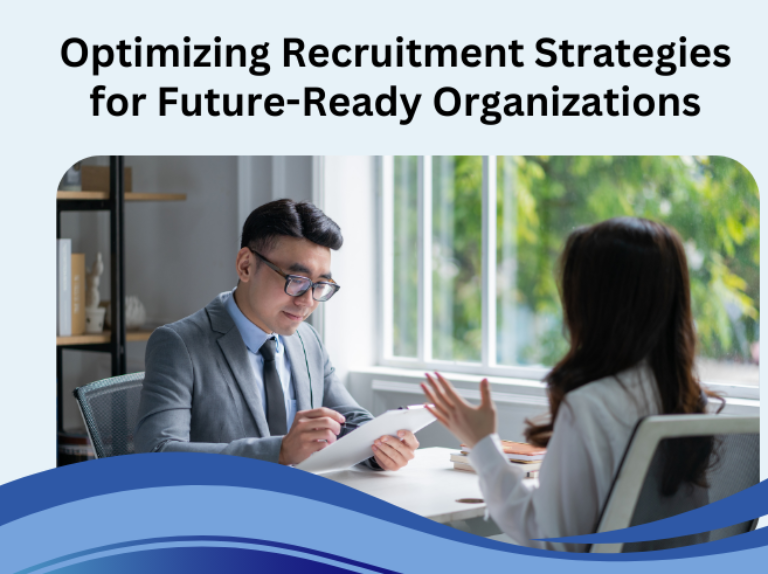Optimizing Recruitment Strategies for Future-Ready Organizations

Recruitment today is no longer just about hiring for vacancies, it is about shaping the future of an organization. For HR managers, CEOs, and business leaders, the challenge lies not merely in filling positions but in cultivating agile, resilient, and high-performing teams that can thrive amid constant change. An effective recruitment strategy is what transforms hiring from a short-term task into a long-term growth driver.
1. Understanding the Real Recruitment Needs
The foundation of effective recruitment strategies in HRM begins with a precise understanding of organizational requirements. Beyond job descriptions, this means identifying the right blend of technical expertise, soft skills, and cultural alignment.
A well-designed needs analysis, carried out in close collaboration with hiring managers, ensures that every role is defined by real-world expectations and future readiness. Clear communication across stakeholders eliminates mismatches and builds trust throughout the talent acquisition process.
2. Harnessing the Power of Recruitment Technology
Modern hr talent acquisition demands more than intuition, it requires intelligent use of technology. AI-powered tools can streamline resume screening, enable accurate candidate matching, and deliver actionable workforce insights.
By automating repetitive tasks, HR professionals gain time to focus on strategic priorities such as nurturing candidate relationships and strengthening the employer brand.
Virtual interviewing platforms, asynchronous video assessments, and data-driven dashboards not only accelerate time-to-hire but also improve the quality and fairness of decisions. In today’s competitive landscape, the ability to optimize recruitment with both efficiency and personalization is non-negotiable.
3. Creative and Proactive Talent Sourcing
The best candidates often aren’t actively applying—they need to be discovered. A forward-thinking recruitment and talent acquisition approach looks beyond conventional job boards and headhunting. Social media engagement, professional networks, niche talent communities, and industry events open doors to both active and passive talent.
Organizations that revisit past applicants, leverage employee referral programs, and invest in succession planning tap into overlooked talent pools. This proactive mindset widens the funnel and strengthens long-term workforce pipelines.
4. Enhancing Consistency and Fairness in Selection
A structured selection process is essential for credibility and fairness. Standardized interview scorecards, competency frameworks, and bias-free assessment tools ensure that every candidate is evaluated on consistent, merit-based criteria.
By embedding data analytics into each stage—identifying bottlenecks, measuring outcomes, and refining processes—organizations can achieve greater transparency and continuous improvement across the recruitment lifecycle.
5. Building Flexibility and a Candidate-Centric Experience
Today’s workforce expects more than a paycheck, they seek meaning, flexibility, and balance. With 60% of job seekers prioritizing hybrid or remote options, organizations that adapt to these preferences significantly expand their access to top talent.
Equally important is a compelling employer brand. From the first job posting to the final offer, consistent, authentic messaging reinforces the organization’s values and builds trust. A strong employee value proposition not only attracts candidates but also creates long-term advocates for the brand.
6. Evolving Through Feedback and Market Insights
Sustainable talent acquisition strategies evolve with changing times. Regular feedback from candidates and hiring managers helps identify pain points, refine the candidate experience, and strengthen internal processes.
Forward-looking organizations stay attuned to trends such as skills-based hiring, AI-enhanced decision-making, and holistic employee well-being. By aligning with these shifts, leaders ensure that recruitment remains both competitive and human-centered.
Final Thoughts
Optimizing recruitment is not a one-time initiative—it is an ongoing journey. Data-driven insights, modern technology, and empathetic, people-first practices together create a recruitment ecosystem where both organizations and candidates thrive.
By fostering trust, embracing innovation, and focusing on long-term workforce agility, industry leaders can secure the talent needed to fuel sustainable growth and enduring competitive advantage.
Popular Tags: Recruitment Strategy | Recruitment Strategy Plan | Sourcing strategies in recruitment | Hire Strategy


